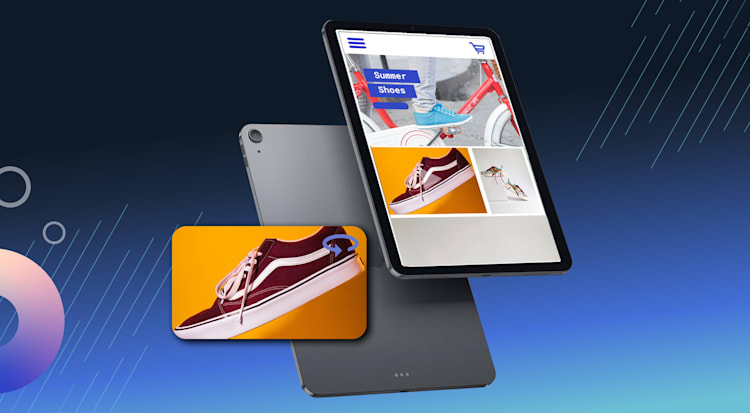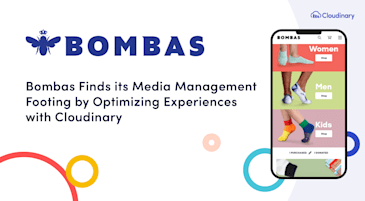Businesses need to engage customers more rapidly and effectively than ever before to stay competitive. As a result, video content is key to presenting products to potential customers in a captivating way.
Video content lets us demonstrate product use, showcase brand personality, and improve search rankings. Incorporating customer testimonials and home reviews into the product experience also enhances credibility and brand integrity. While we can capture customer interest with photos or detailed descriptions, video retains attention more effectively — increasing conversion rates and revenue.
In this article, we’ll explore video as a vital part of e-commerce and the challenges of integrating video content into marketing campaigns. Then, we’ll discover how Cloudinary can help ease both the technical and creative burdens of introducing video content into an e-commerce platform.
As new technologies make video creation, management, storage, and distribution easier and cheaper, the popularity of video as an e-commerce tool has skyrocketed. With the advent of 4K and ultra-high definition video — a feat that even many mid-grade smartphone cameras can now achieve — we have greater means to create and distribute high-quality video content across numerous platforms.
In addition, advanced fiber optics facilitate data transfer across the web at previously unparalleled speed and minimal cost. This enables internet service providers to offer bandwidth capabilities for seamless video streaming. And, as these streaming capabilities diminish the need to download video, we’re less limited by the storage restrictions of the average device.
While the latest technologies help push the use of videos in advertising, the most significant contributor to this proliferation is customer expectation. Statistics show that 33% of people prefer to learn about products by watching a video. This isn’t a surprise since most people are used to streaming videos on Netflix, YouTube, and social media sites. That’s why 80% of consumers have more confidence in purchasing a product after watching a video demo. It provides an extra level of confirmation that the product they’ll receive will appear as it does on-screen.
When video content is exceptional, customers also share it with friends and family directly or via public platforms. Social sharing expands the potential content reach by several degrees and at no additional cost. Overall, video’s widespread availability and virality means that consumers now expect it, making it all but essential for successful marketing.
Companies that have embraced video give credence to the phrase “content is king” through their revenue statistics alone, since 81% of marketers report increased sales thanks to video marketing efforts. This data tells us that video is an ideal medium for communicating how products can meet customers’ needs.
One of the most critical benefits of video is that it incorporates audio and visual elements into its storytelling, appealing to multiple senses for greater viewer engagement. Including photos and detailed information within video content makes the format especially effective for telling the complete story of what the product does, how it does it, and why you need it.
As an added benefit, 49% of businesses attest that the information provided through video content reduced the number of support calls they received.
While video marketing offers many benefits, continuously creating engaging e-commerce content presents unique challenges.
Creating high-quality videos to optimally showcase a product can be expensive. Whether contracting with a specialized company or creating content in-house, we’ll likely encounter significant up-front investments in personnel, technology, and subscriptions. Additionally, moving from customer expectation is an initial idea to its final delivery demands substantial time and creative efforts. These factors become formidable obstacles to generating consistently fresh content.
Customers want clear, concise videos that tell them what they need to know within a short time. They also expect the video to load and play quickly regardless of their device or connection speed. However, producing a crisp video with skillful storytelling requires both time and considerable storage resources. Addressing these constraints can be challenging for a business that doesn’t specialize in video content creation.
Incorporating a video into a website can require writing a lot of code. If the website framework doesn’t accommodate a variety of display types, connection speeds, and browser capabilities, it can degrade user experience and reduce the chances of successful conversion.
Conversely, distributing videos on platforms such as YouTube requires promotion (e.g., paid ads) to reach the necessary audience. This kind of promotion means additional time and financial investments with little guarantee of recovering these costs.
Video content becomes stale quickly. We need to create new content regularly to sustain our audience’s attention. However, brainstorming a steady stream of new and captivating ideas poses a significant challenge even for the most adept creative teams. The challenge is even greater if the business doesn’t release new products often.
In today’s content-filled world, garnering audience attention requires substantial, consistent creativity. We’re competing against funny animals, sports highlights, movie trailers, and direct competitors. To stand out, we need to tell compelling stories to customers that attract instant interest — and we need to do it frequently.
Unlike image content, video data is heavy and requires significant optimization of its visual and audio components. Factors such as upload and download rates, CPU and browser capabilities, display resolutions, format compatibility, and video codecs make managing and distributing video content complicated and time-consuming.
With Cloudinary, you can easily manage and distribute video and image content. Its powerful features help ensure your media files are always fresh in the eyes of your customers.
Cloudinary’s dynamic URL transformation tool creates instantly distributable content from user-generated content (UGC). By programmatically cropping and resizing images and video uploads from your end users, it relieves your team of the tedious, time-consuming, and costly manual editing processes that diminish their creative energy.
Another of Cloudinary’s powerful features is chained transformation. This feature enables you to submit a URL with several transformation components, which Cloudinary can then apply to the linked media on the fly. This means that, with a single URL request, we can rotate a video, change its zoom or crop settings, and add a filter and custom border. While an adept video editor could perform these transformations, they would need to alter the raw file and make several versions to accommodate multiple viewing platforms.
Cloudinary takes this process one step further with named transformations. This feature allows us to assign a custom name to a predefined set of transformation parameters. So, if we know that we’ll want to apply the same set of parameters to all videos on an Instagram feed, we don’t have to manually define a set of transformations for each video. Instead, we can define and name a set of parameters, call it by name, and let it perform the desired set of transformations.
Video has become indispensable to the e-commerce space. Businesses that use video content to deliver engaging, compelling stories achieve significantly higher conversion rates than those relying on images.
Cloudinary can help you solve the challenges of video size, quality, and multi-platform access. Try Cloudinary today to learn more.



